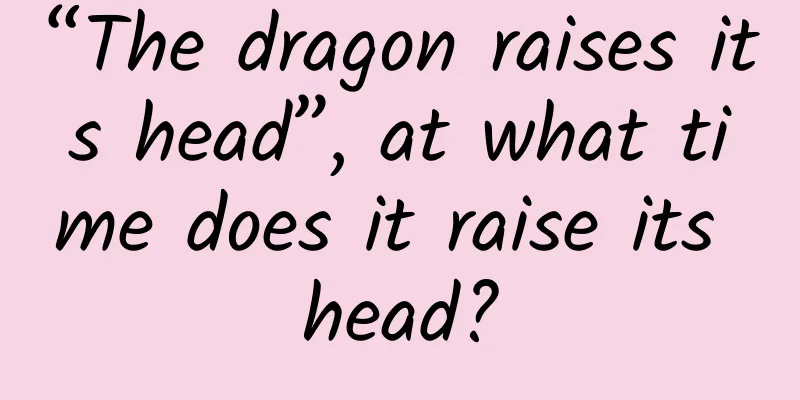“The dragon raises its head”, at what time does it raise its head?

|
February 21st marks the day when the Dragon raises its head. According to astronomical science experts, this year's Dragon raises its head around 10 p.m. What does "Dragon raises its head" mean? At what time can we see it? Wang Kechao, the director of science popularization at the Purple Mountain Observatory of the Chinese Academy of Sciences, introduced that in order to observe celestial phenomena, ancient Chinese people divided the stars in the celestial equator and the ecliptic into 28 star groups, called the 28 Mansions. Among the 28 Mansions, each group consists of seven: the eastern one is the Azure Dragon, the southern one is the Vermillion Bird, the western one is the White Tiger, and the northern one is the Black Tortoise. "The Eastern Azure Dragon includes seven constellations, namely Jiao, Kang, Di, Fang, Xin, Wei and Ji, which vividly outline the image of a dragon: Jiao is the head of the dragon, Kang is the neck, Di is the chest, Fang is the belly, Xin is the body, and Wei and Ji together represent the tail of the dragon." Wang Kechao said, "The Dragon Raising its Head" reflects the image of Jiao rising from the eastern horizon, as if the "head of the dragon" has been raised. About 2,000 years ago, the ancient Chinese saw the "Dragon Raising its Head on the Second Day of the Second Month" shortly after sunset. Due to the precession of the equinoxes, people today generally see the "Dragon Raising its Head" at around 8 or 9 p.m. on the second day of the second month of the lunar calendar. This year, the time to see the "dragon raising its head" is relatively later, around 10 o'clock in the evening. Wang Kechao explained that in addition to the influence of the precession of the equinoxes over the years, the time when the same stellar phenomenon appears in a day is also related to the early or late Gregorian calendar date. The same star rises about 4 minutes earlier every day than the previous day. The second day of the second month of the lunar calendar this year corresponds to the Gregorian calendar date of February 21. The time of "dragon raising its head" on that day is more than an hour later than "February 2, dragon raising its head" on March 14, 2021. In the nearly two months after the second day of the second lunar month, the public can see the "dragon head" Jiao Su rising from the horizon at different times of the night. It takes about 6 hours for the entire "Cang Long" to rise from the horizon. From mid-July to mid-October of the Gregorian calendar, the public can see the entire "dragon shape" of Cang Long appear in the night sky after dark. |
<<: Spring is here. Are you doing the right thing to make your child taller?
>>: Spring is here, how can we move scientifically?
Recommend
Beauty industry hot-selling course: Beauty industry account formula
Course Catalog ├──01、The beauty industry IP I inc...
7 major channels for promoting Douyin and increasing followers!
If it is an enterprise account, it is recommended...
The "Beijing Man" who disappeared in the war tells us the value of peace
Beijing is a city with a history of more than 3,0...
It's getting fierce. Sharks are having a "pajama party" | Nature Trumpet
Welcome to the 63rd issue of the Nature Trumpet c...
5 ways to promote WeChat mini programs!
According to the latest data, the main entrances ...
User operation: How to do user segmentation?
We have said that user stratification is a specia...
How to increase the payment rate of educational products?
Have you ever wondered: Why do women always buy b...
What’s the innovation behind Google’s new Android smart lock?
On March 23, according to foreign media reports, ...
What is the role of friendly links in website promotion? What is the role of friendship links?
A promotion method that many webmasters are famil...
Does the sound of the air raid sirens make you nervous? It turns out that sound has such an effect
In the movie "Air Battle", a Mirage 200...
Douyin dou+ advertising strategy!
Recently a friend told me that it is not easy to ...
Today is the Autumnal Equinox丨Blue sky, yellow leaves, autumn colors
" Fen means equal. This is half of the ninet...
New travel companies will split 40% of profits, and China will seize the initial advantage
Recently, Boston Consulting Group showed that by ...
How to create a fresh food mini program? How much does it cost to make a fresh food mini app?
Fresh food mini-programs are very popular nowaday...
Are meteorological proverbs reliable? Is there any scientific basis for predicting the weather by looking at the clouds?
Author: Science History Commentary Wu Jingping Wh...









